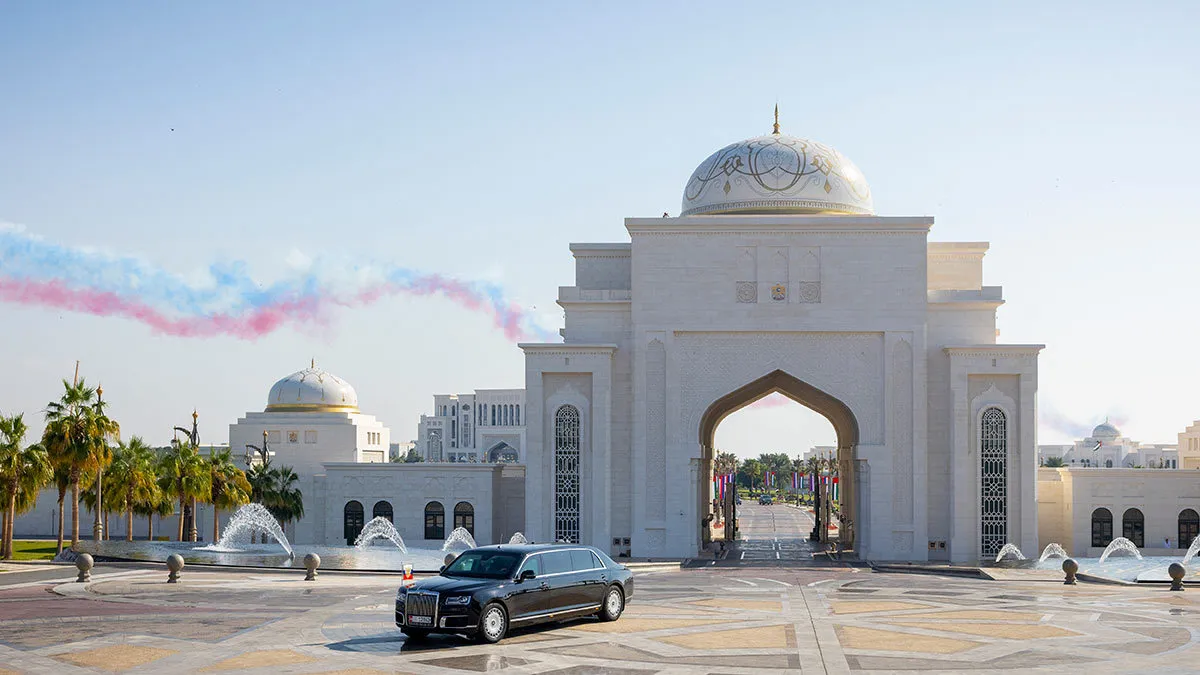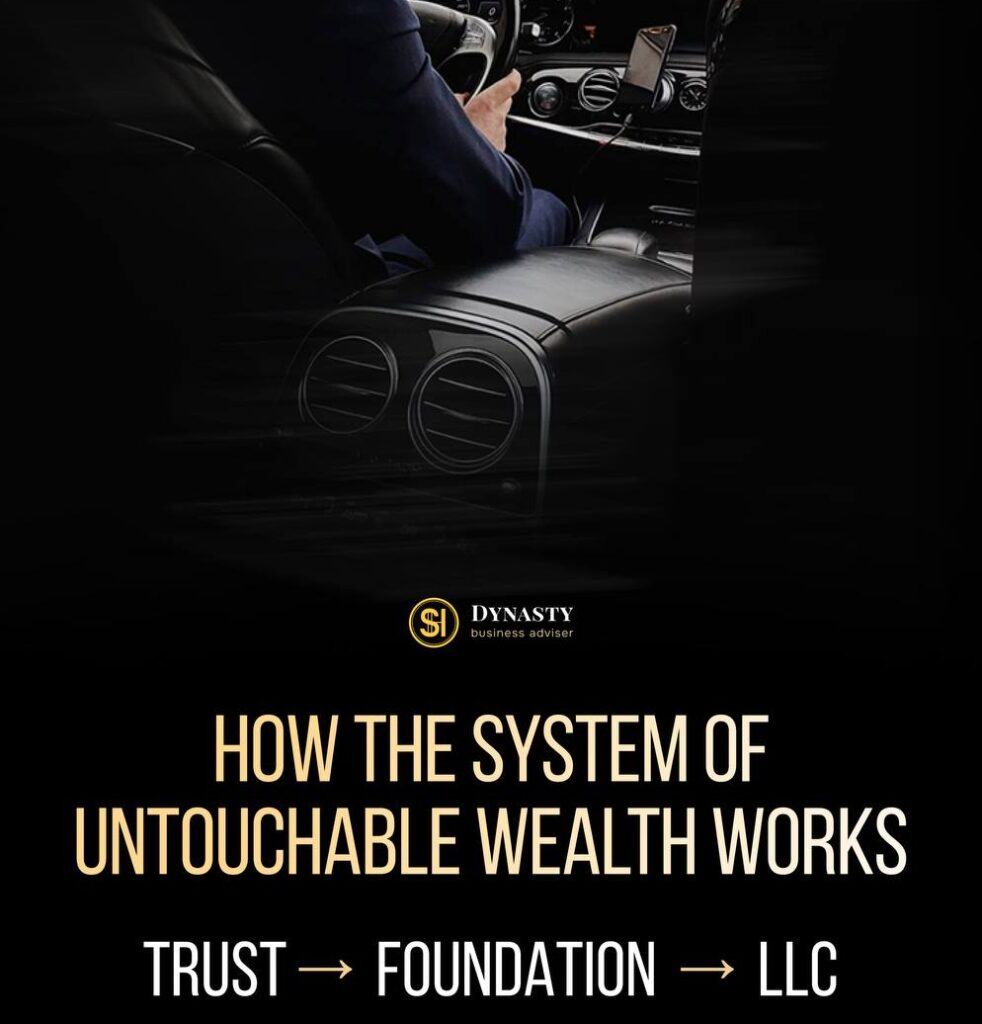
In a world where a single court ruling can freeze accounts and changes in tax legislation can devalue a business, asset protection has become a vital tool. The classic scheme, where all property and capital are registered to a single company or relatives, has long been outdated.
Therefore, wealthy business owners are increasingly creating multi-level capital protection by combining a trust, a fund, and a legal entity (LLC) into a single system. How exactly this works and how to use these tools in the UAE will be discussed in this article.
Why do the wealthy hide property rights rather than money
As long as property is registered to a specific individual, it is legally linked to the owner. And liability for obligations, lawsuits, or tax claims may affect personal property.
If an asset is registered to a trust, offshore company, or nominee owner, the legal connection to the actual owner becomes hidden. This complicates the seizure, arrest, or identification of the asset.
The wealthy do not simply hide their money — they hide their ownership: a yacht may be registered to a company with a nominee director, real estate to a trust with a beneficiary whose name does not appear anywhere.
This structure allows you to maintain control over your assets without direct legal liability. It is particularly important in countries with unstable legal systems, high risks of property confiscation, or political pressure. As a result, if a person is sued, their savings do not legally ‘belong’ to them. Therefore, they cannot be seized.
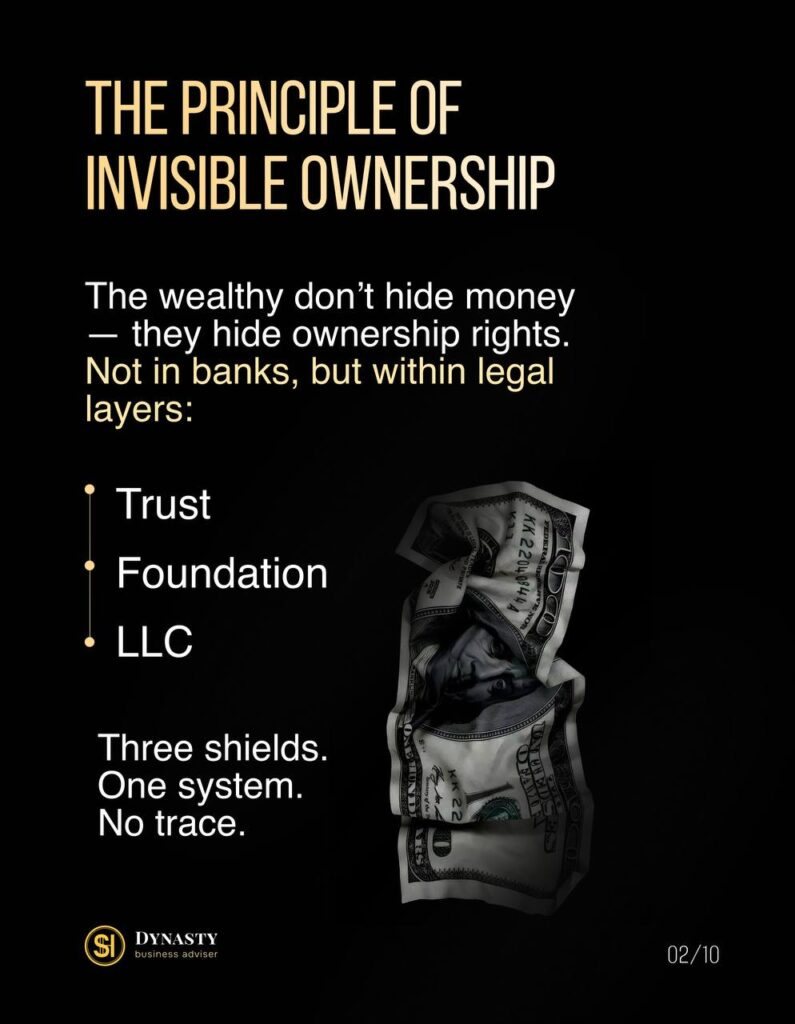
How three-level capital protection works
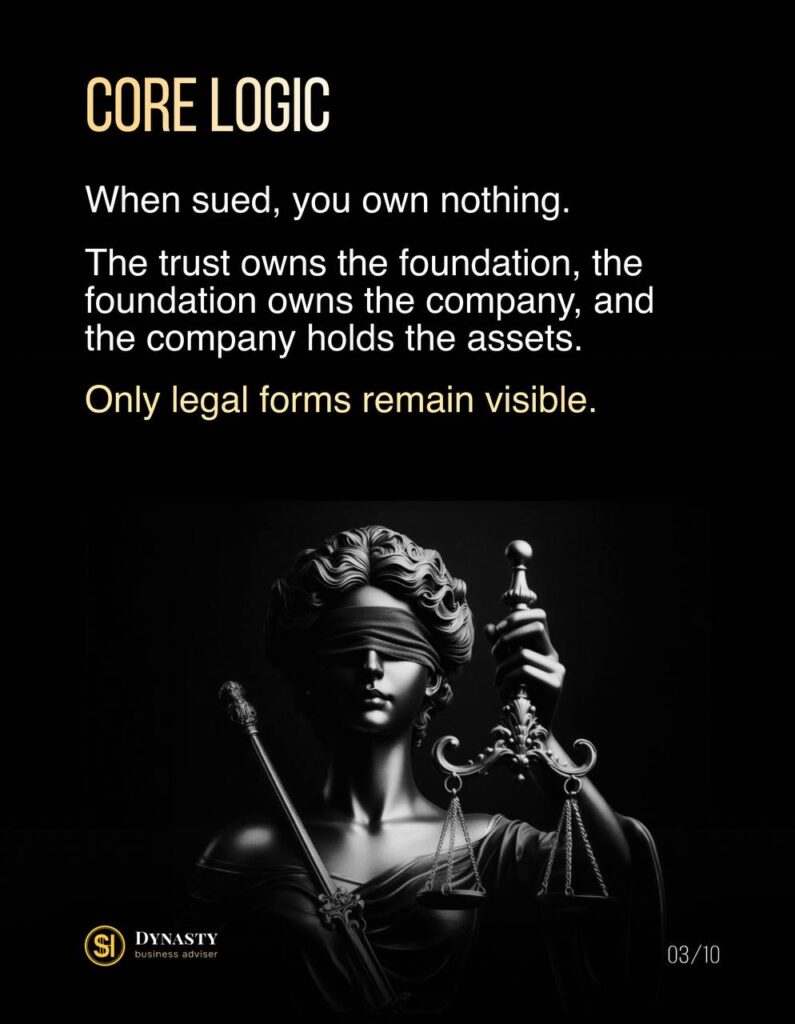
Legal attacks on wealthy individuals are not uncommon. The reasons vary: debts, divorce, corporate conflicts, tax claims, political situation. But the goal of the persecutors is almost always the same — to get hold of someone else’s property: to seize accounts, freeze real estate, block business operations, and then take everything away. To avoid this, wealthy families build a three-tiered protection of assets for their businesses and families.
The system is based on the division of ownership, management, and control rights over assets, which often belong to different entities — individuals or companies. How it works:
- Ownership of assets is legally secured, but not by a natural person.
- Management of the property is transferred to a trusted entity — a management company or nominee director.
- Control over the funds is effectively retained by the actual owner, who does not appear in the documents, does not participate directly in management, and is not disclosed in public registers.
Level 1. Trust – Legal Capital Management Centre
When an attack begins, property registered in your name becomes vulnerable. It can be seized, challenged, included in a lawsuit, or used as evidence. To prevent this from happening, assets are removed from direct ownership in advance and secured in a legal structure where your name no longer appears.
A trust is a legal shell in which assets cease to be personal but do not lose controllability. It is created under pre-defined conditions and acts as an autonomous structure that protects capital from external pressure.
Here’s how it works:
- The founder transfers assets to the trust, relinquishing formal ownership.
- The trust manager obtains the right to dispose of the capital — strictly in accordance with the terms specified in the trust agreement.
- The beneficiary (who may be the owner) retains actual control: they receive benefits, can change the manager, and adjust the rules and structure.
- The legal shell of the trust separates the assets from the individual, making them inaccessible to direct attack.
As a result, the structure allows you to maintain control without breaking the law, while removing assets from the risk zone. You do not appear in the registers. In court, you are not the owner. But the business works for you according to your rules.
Level 2. Fund – legal shell of ownership
The trust sets the rules but does not work with the assets directly. For this purpose, a fund is created – a legal entity that takes on the functions of managing and distributing property. The fund operates under a charter approved by the founder. Its main purpose is to hold capital within the established rules, while ensuring its lawful use.
How such a structure works:
- The founder (or trust) contributes assets to the statutory fund. The procedure for disposing of them is set out in the charter.
- The fund’s board or appointed director manages the property, signs agreements, opens accounts, and owns shares in companies.
- Control over the fulfilment of all conditions is exercised by the owner, which is the trust.
The fund becomes the administrative centre of the system: all decisions related to the management and movement of capital pass through it. Incidentally, the main difference between a trust and a fund is autonomy: a trust depends on management conditions, while a fund is an independent structure. However, a trust is necessary to maintain control over assets without legally disclosing one’s participation.
Level 3. The company – a tool for external operations
At this level, the structure enters the external environment. The company is registered as a foundation and becomes an operational tool. All activities are conducted through it, contracts are concluded, accounts are opened, and assets are registered. The company represents the interests of the structure in business relations, but does not have any capital of its own. Its task is to operate within the rules set by the trust and the foundation, ensuring legal purity and economic flexibility.
The main functions of the company are:
- acting as a party to contracts, leases and investments;
- receiving and distributing income for the benefit of the fund;
- opening accounts, obtaining licences and managing assets;
- serving as a legal intermediary between the structure and counterparties.
If the management of the company is transferred through a trust, the participation of shareholders is not disclosed. The LLC is visible to regulators and partners, but its internal connections are hidden, which allows for anonymous ownership of assets.
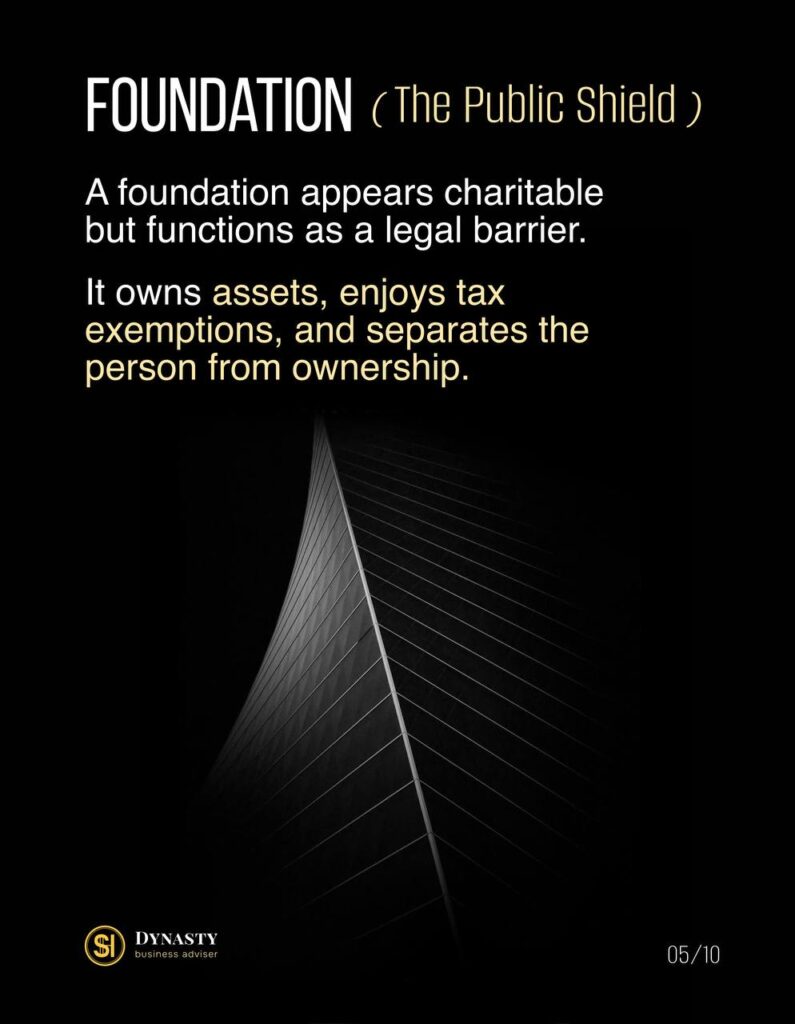
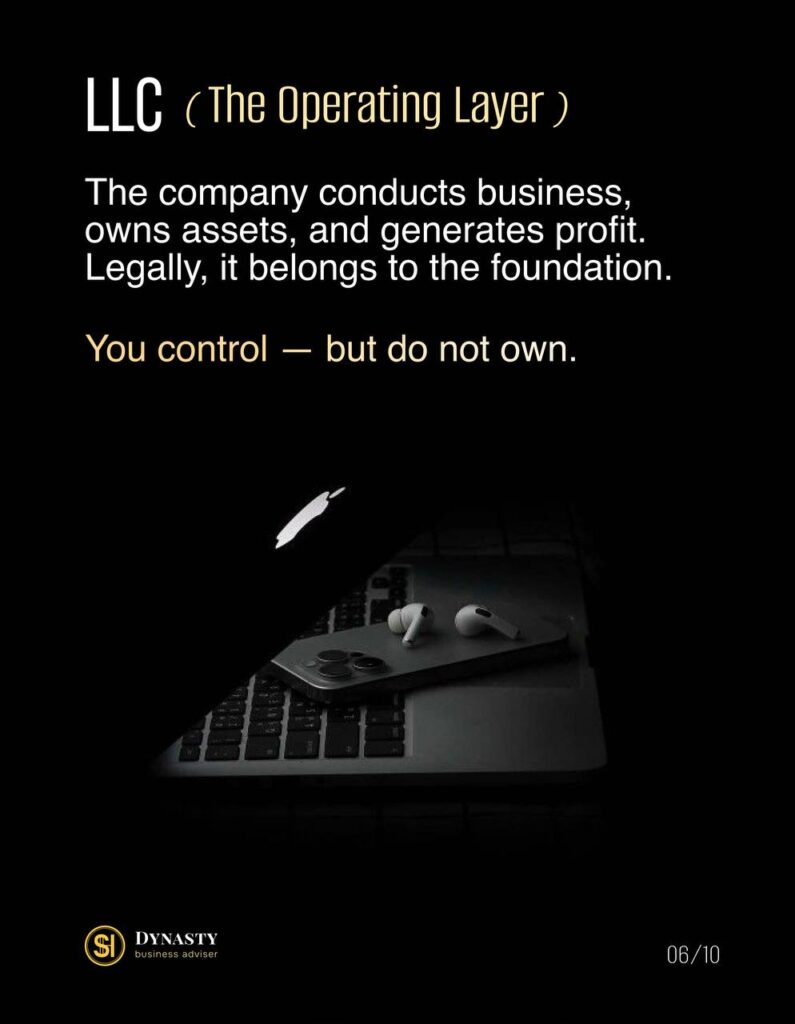
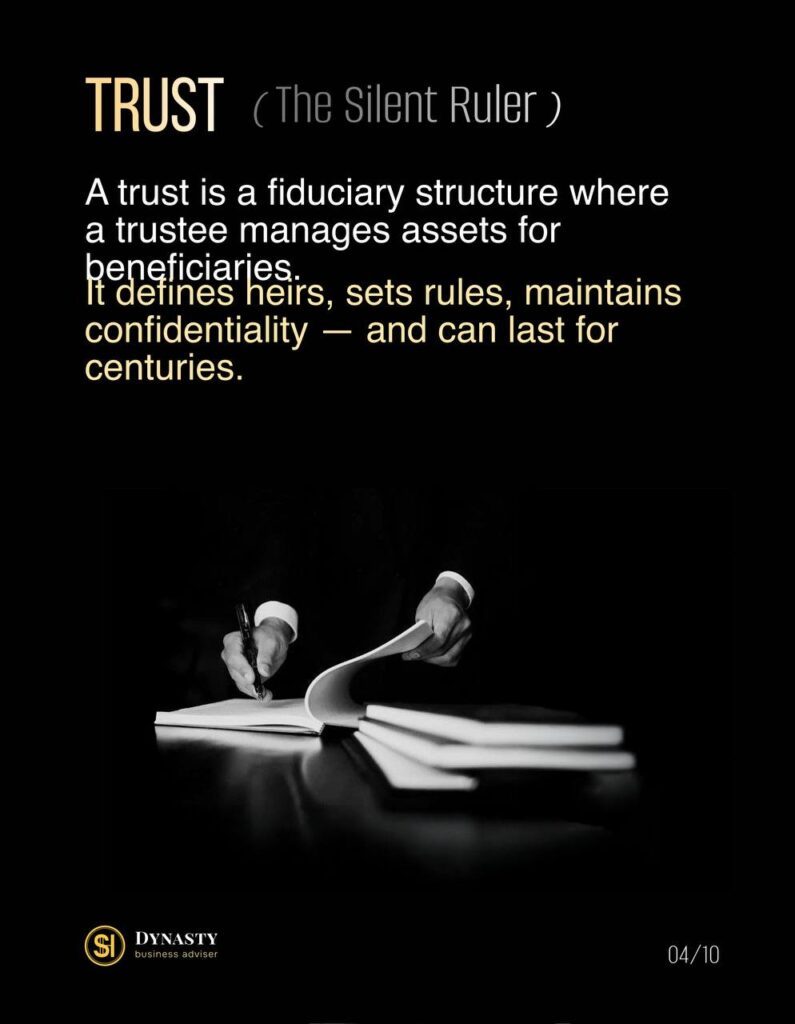
Why the three-tier structure is virtually invulnerable
In the world of digital registries, where assets can be attacked and privacy is virtually non-existent, a three-tier structure is essential.
This legal structure allows you to remain in the shadows while continuing to own and manage your savings.
Its stability is ensured by the distribution of functions between levels — each is responsible for a separate process and is legally isolated from the others:
- The fund is a public shield. It acts as the legal owner of assets and manages them according to set rules, acting as a fortress. It looks like a charitable enterprise, but it owns real estate, businesses, intellectual property, and does not pay taxes. Formally, it owns the company. And you? Just a hired manager.
- The company is a profit machine. It performs external operations, interacts with counterparties and banks, and pays taxes. The LLC bears operational risks but owns the property. All assets are in the fund. All rules are in the trust. You run the business but do not risk your property.

- A business trust is a silent conductor that sets the rules of management and controls their implementation. It manages the fund, ensures anonymity, and can exist for as long as necessary. You are not considered the owner, but you control everything. Like a shadow.
This creates a confidential ownership structure, where each level strengthens the overall security perimeter. Even if one of them is subject to verification or restriction, the others continue to function. How exactly? Let’s imagine a hypothetical situation where one link in the chain is attacked.

Audit or claim against the company
Let’s say an operating company is subject to an audit, tax inspection or commercial dispute. The regulator only sees it — a legal entity registered to the fund. The fund and trust are not involved in the audit because they are not parties to the business transactions.
Even if the company’s accounts are temporarily frozen, the assets remain with the fund, and management remains with the trust. If the dispute settlement is delayed, a new company can be created without affecting the other structure.
Fund audit
If the supervisory authority requests the fund’s documents for AML or KYC compliance analysis, the trust remains outside the scope of control. The company continues to operate because it is legally independent and subject to its own regulations. Why? It is not for nothing that they say that a fund is a reliable shield for protecting property. Yes, it owns assets, but it does not engage in commercial activities. As a result, the audit does not give access to the trust and does not impact the company’s operations.
Claims against the trust
If claims are made against the trust, the fund, and the company continue to operate as usual while its documents are being checked. Assets remain assigned to the fund, bank accounts remain active, and contracts remain in force.
After the audit is completed, the trust structure does not need to be changed – its lower levels remain fully operational. And if, for some reason, the trust is closed, it can be replaced or re-registered without affecting the fund and the company.
Thanks to the three-tier structure, capital remains protected, and asset management remains stable and legal in any jurisdiction.

Who uses multi-level capital protection and why

Of course, a multi-level structure is not a tool for everyone, but for a specific group. It is used by those who manage large amounts of capital and want to maintain control while ensuring full legality of ownership.
Who needs such protection:
- owners of family estates, to secure inheritance and avoid disputes;
- politicians and public figures – to protect themselves from political and legal risks;
- religious organisations and foundations – for long-term management of property and donations;
- founders of IT companies after selling their business – to withdraw capital from the operating company;
- patrons and philanthropists – for transparent distribution of assets and management of funds.
This system may seem complicated at first glance. But it is precisely its multi-layered nature that makes it stable, legitimate, and effective. That is why it is used by everyone who thinks strategically — decades ahead — in order to pass on their legacy to their loved ones, preserving the ideas, mission, and structure of the family business.
How to build your protective wall correctly
A multi-level system requires precise planning and professional training. A mistake in interpreting the law or choosing a jurisdiction can lead to data leaks, double taxation or loss of control over capital. Therefore, it is better to start building your wall by consulting experts. After all, situations vary. It is no coincidence that questions about how to protect assets abroad are becoming increasingly relevant.
If a business and inheritance are tied to one country, then all protective mechanisms are subject to its policies. This may be sufficient as long as the system is stable. But as soon as external pressure, sanctions, restrictions on capital movement or regime change appear, all protection becomes vulnerable. For example, the state may prohibit corporate rights, restrict access to bank accounts or make taxes unaffordable.
This does not mean that all your efforts are in vain. With the right approach, offshore trusts and funds can help you resolve the situation with your business in your favour. Below are the steps that experts may suggest.
Legal audit and planning
Any protection begins with an inventory. Therefore, specialists will start with a legal audit: they will analyse the ownership structure, obligations, corporate ties, inheritance risks and the degree of transparency. This is necessary to identify vulnerabilities that may arise under external pressure, changes in jurisdiction or cross-border disputes.
Based on the audit, a strategic map is formed:
- which assets need to be isolated;
- which structures need to be reorganised;
- which risks need to be insured or transferred;
- which elements require separation between personal, family and corporate property.
At the legal planning stage, mechanisms are put in place that will work even in the event of a change of regime, sanctions, or channel blocking. This is the first step towards systematic protection of capital from court and other claims.
Transparency and tax neutrality
After the audit, it is important to build a structure that is understandable to banks, notaries, tax authorities and even heirs. Transparency is controlled openness: when the origin of assets, the logic of ownership and the routes of capital movement are legally clear and easily understandable. Tax neutrality means that the structure does not lead to double taxation or loss of benefits and preserves the company’s competitiveness in the market.
How specialists can help:
- align the owner’s goals — personal, corporate, inheritance — with the legal architecture of ownership;
- select a tax-neutral jurisdiction, taking into account the possibility of avoiding double taxation and currency control;
- document the origin of funds and capital movement routes;
- prepare the structure for bank verification (KYC, AML, compliance);
- verify the compliance of the selected model with the requirements of tax and currency legislation.
As a result, you get a transparent legal structure that works without unnecessary questions from banks, counterparties, or regulators, as well as without blockages and legal risks.
Choosing trusted intermediaries and managers
This stage is one of the most significant and vulnerable. At this stage, third parties appear in the structure: nominal directors, trustees, and managers. And you will have to delegate not only functions, but also access to information, assets, and signing rights. Even a perfectly constructed model loses its stability if random executors are involved. Mistakes made by intermediaries can be very costly, especially when working across multiple jurisdictions, where each failure is amplified at the intersection of legal systems.
To avoid risks, select trusted individuals based on the following criteria:
- Licence and reputation. The manager or nominee company must operate within the law, have a transparent history and positive customer reviews.
- Competence in the relevant jurisdiction. The lawyer or administrator must be familiar with local legislation, the specifics of the tax regime and the requirements of banks.
- Confidentiality. All participants are required to guarantee the non-disclosure of information about the owner, beneficiaries, and sources of funds.
This approach minimises the human factor and maintains control over the system.
Which protection structure is right for you: classic or three-tier
The depth and architecture of the structure determine how the business will survive audits, changes in jurisdiction, inheritance, and banking compliance. In practice, two models are most often compared: classic and three-tier legal architecture. We discussed the latter in detail above, while the classic model refers to simple structures with a single level of protection.
The difference lies in the depth of protection, distribution of functions, and resistance to external control. For example, models where assets are registered either directly to an individual, a single company, or a fund, without additional levels of protection or separation of functions.
Below is a comparison of the key differences that will help you choose the right configuration.
| Parameter | Classic structure | Three-tier structure |
|---|---|---|
| Composition | Ownership directly or only through a limited liability company, fund, or trust | Trust + fund + company (legally separated functions of ownership, use, and management) |
| Resistance to audits | Vulnerable to requests and blocks | Risk distribution, protection from personal claims |
| Flexibility when changing jurisdiction | Requires complete re-registration | Allows changing elements without destroying the entire model |
| Privacy protection | Limited | Multi-level, with access restrictions |
| Asset management | Directly, through the owner | Delegated, with control through documents |
| Cost of implementation and maintenance | Lower than more complex | Higher than classic, but justified for international work |
| Speed of launch | Fast | Requires preparation, approvals, and verification |
The classic model is simpler, cheaper, but more vulnerable. The three-tier model is more complex and expensive, but it provides greater protection and flexibility when working internationally.
Benefits and advantages of a complex scheme
A multi-level structure protects capital at all levels — legal, financial, and operational. It makes asset management predictable, reduces risks, and ensures control even under external pressure. In addition, such protection allows you to:
- Divide risks by level: operational, personal, political – each layer works independently.
- Flexibly scale your business: add assets, change managers, connect partners without re-registering the company.
- Manage trust: a transparent structure increases creditworthiness, investment attractiveness, and reduces counterparty anxiety.
- Maintain control without formal ownership: especially important during relocation, sanctions, divorces, inheritance.
- Create continuity: the structure outlives a person and can operate as a family business for generations.
As a result, the system works like a well-oiled machine: each level reinforces the other, creating a balance between legality, security, and effective management.
How to implement a multi-level asset protection system?
A single instrument—be it a trust, fund, or company—does not provide sufficient protection. Modern risks require a comprehensive approach: legal shielding, separation of functions, flexible management, and resistance to external pressure. It is precisely this multi-level structure that allows you to maintain control, reduce vulnerability, and ensure continuity.
Company Dynasty Business Adviser provides turnkey support for such projects, from developing the architectural framework to its legal and operational implementation. We work with private clients, family structures, and international foundations, providing strategic asset protection.
Our benefits:
- We are accredited specialists with international experience.
- We have experience working with large assets, family foundations, and cross-border structures.
- We possess deep legal expertise in the areas of trusts, foundations, corporate law, and inheritance.
- We build architecture tailored to the client’s goals: from capital protection to inheritance transfer and long-term management.
- We provide full support: from designing the structure to its implementation and support.
- We ensure confidentiality and transparency: we provide protection for personal data and assets while maintaining legal clarity and transparency for partners, investors, and regulatory authorities.
If you want to preserve your capital and pass it on to your heirs, we are fully prepared to help you achieve your goals. We understand better than anyone that comprehensive protection begins with the right architecture.


